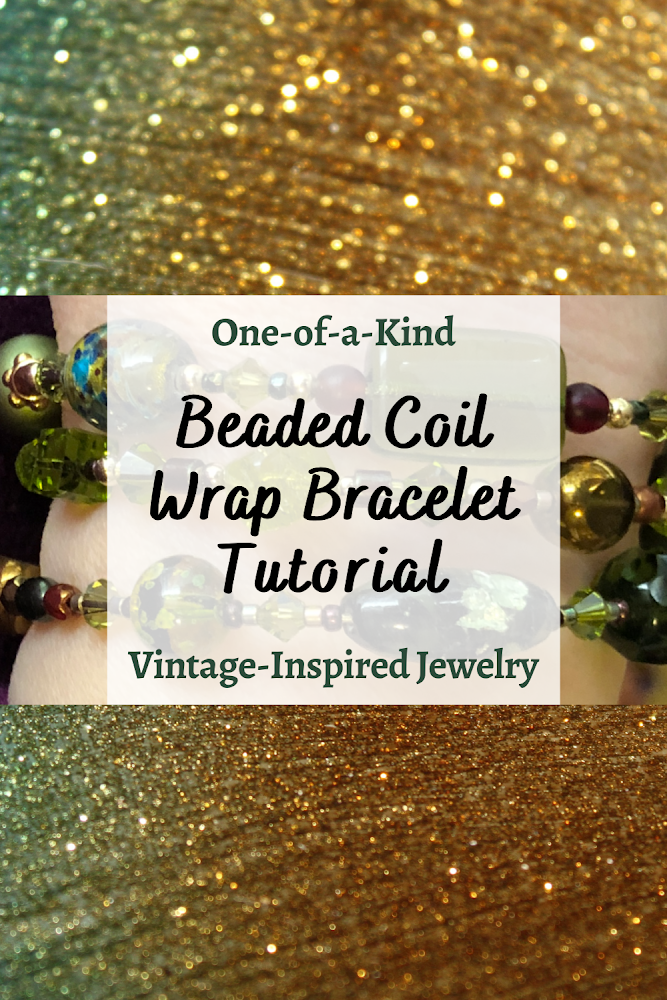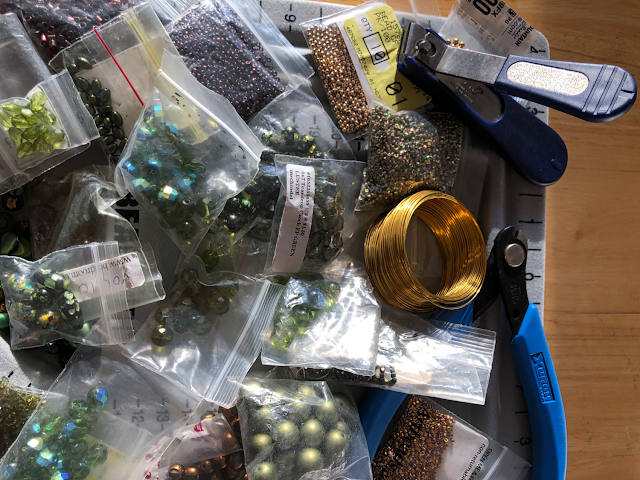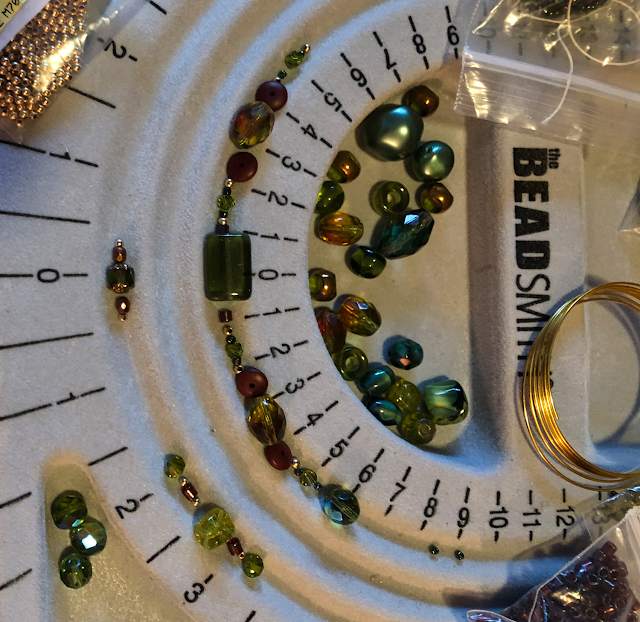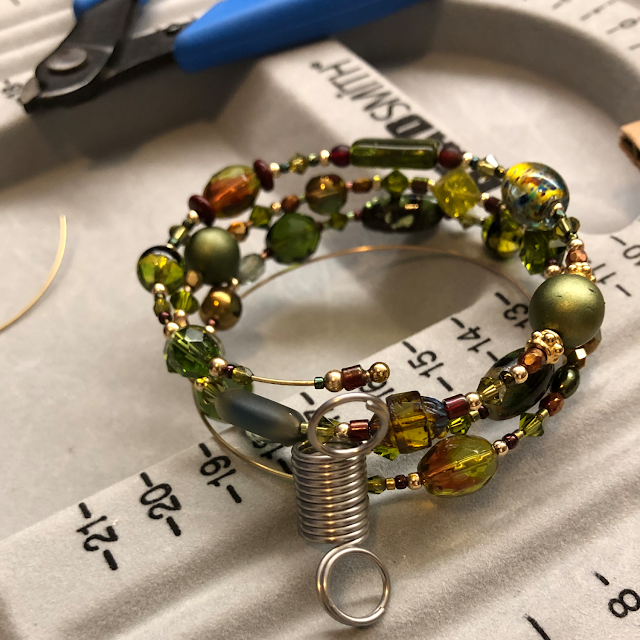Beaded bracelets are wonderful accessories that can add a pop of color to any outfit. Unlike necklaces and earrings, bracelets allow you to enjoy looking at them throughout the day while you’re wearing them. Vintage beaded coil wrap bracelets from the 1940s and 1950s designed by top jewelry icons of that era, such as Miriam Haskell and Robert DeMario, are coveted by vintage jewelry collectors. They have also come back into fashion repeatedly, for good reason.
While bracelets with clasps can be quite challenging to fasten and unfasten, even with a bracelet helper tool, beaded coil wrap bracelets made with memory wire are a cinch to put on and take off your wrist. During my three decades of designing, making and, periodically, selling one-of-a-kind beaded jewelry, my coil wrap bracelets featuring vintage beads have remained among my most popular jewelry designs, regardless of fashion trends.
In this jewelry tutorial, I’ll review how I made my most recent memory wire coil wrap bracelet with a mix of contemporary and vintage beads, which is a birthday gift for a very dear friend. The friend for whom I made this one owns several beaded coil wrap bracelets I’ve designed for her in different colors. She loves wearing them so much that when I asked her what type of jewelry she would like me to make as her birthday gift this year, she requested another coil wrap bracelet, this time in shades of olive green.
These beautiful, classy, distinctive bracelets make wonderful gifts for any jewelry lover (including yourself), and especially for someone who has difficulty putting on or taking off her favorite bracelets with clasps.
Beaded Memory Wire Wrap Bracelet Tutorial
Materials, Tools and Supplies You Will Need
- Assorted beads in a range of sizes, shapes, materials and surface finishes.
- I used a combination of rare vintage glass beads, vintage Swarovski crystals, contemporary glass beads, including Japanese and Czech seed beads and glass pearls, and small (2mm and 3mm) 14k gold-filled beads.
- I've written an article on The Best Sources for Vintage Beads, Findings and Jewelry Components, if you are interested in using vintage beads in your memory wire beaded coil wrap bracelet designs. Buying beaded jewelry at thrift stores, auctions and estate sales and taking them apart can be a great way to buy more unusual and vintage beads less expensively.
- You can also make beautiful bracelets with inexpensive beads from the crafts store, if you prefer.
- A bead board.
- While not strictly required, a bead board will make it much easier to plan out, play "what if" and rework parts of your design.
- The BeadSmith bead board I use has three channels for designing multi-strand bracelets and necklaces, a flocked surface to help keep beads from rolling around too much as you are laying out your jewelry designs, six recessed compartments of different sizes to hold and organize beads, findings and other jewelry components, and a plastic cover to protect your work-in-progress from dust and keep your laid-out design in place in between work sessions.
- Steel bracelet memory wire.
- Since I was using gold spacer beads, I chose gold plated steel memory wire for bracelets for this project.
- Memory wire cutters.
- Memory wire is extremely hard steel wire that will ruin the cutting jaws regular jewelry wire cutters intended for softer metal wire, such as silver, gold or copper. I highly recommend using either memory wire cutters made specifically for this purpose or a heavy-duty wire cutter from the hardware store.
- An old, heavy-duty toenail clipper with straight or slanted (but not curved) jaws that you don't mind ruining is another option.
- Bead stoppers.
- These are steel coil spring clamps that prevent beads from slipping off stringing wire. I find they are also useful when stringing beads on memory wire bracelets.
- I have both the basic Beadalon wire bead stoppers, which I am showing in this project because they are less expensive, and the cushioned Soft-Flex wire bead stoppers, which I prefer because they are more comfortable to use and less likely to escape from your fingertips.
- As an alternative, you can try using ribbed clear silicone ear wire clutches, if the holes fit your memory wire.
- Memory wire end caps.
- Memory wire end caps are half-drilled metal beads that are glued onto the trimmed ends of the memory wire to keep the rest of the beads in place on the finished memory wire wrap bracelet and leave a smooth, rounded end that won't scratch or snag on clothing.
- Choose silver-plated or gold-plated end caps to match your wire or spacer/accent beads.
- Alternatively, you can use heavy-duty memory wire looping pliers to turn a small loop at each end of the wire. Finishing the ends with small loops also gives you the option of making and attaching beaded dangles to them.
- Strong, two-part epoxy glue that dries clear.
- I highly recommend J-B Weld MinuteWeld Instant-Setting Epoxy, which dries clear, sets in one minute and cures in one hour (which is what I used for this beaded coil wrap bracelet project) or J-B Weld ClearWeld Quick-Setting Epoxy, which also dries clear, sets in 5 minutes and cures in one hour, if you need a bit more "open time" to fiddle with the epoxy before it sets.
- Wooden toothpicks and scrap cardboard.
- Toothpicks and pieces of cardboard cut from shipping cartons or cereal boxes are the perfect disposable mixing tools and palettes for preparing and applying small amounts of clear two-part epoxy to the ends of the wire.
- Close-fitting latex or nitrile exam gloves.
- You'll wear these to protect your fingers while sliding small spacer beads and memory wire end caps onto the epoxy-coated wire ends. Choose gloves that are aren't too large, too loose or too thick to maintain the dexterity required to hold the small memory wire end cap beads securely and quickly maneuver the wire into the small holes before the epoxy sets.
- I find that unpowdered nitrile exam gloves work great for this purpose.
- Ultra-fine point permanent marker.
- I use a Sharpie ultra fine point permanent marker for marking the sections of memory wire where the epoxy should be applied at each end.
Step 1: Choose Your Color Scheme and Assemble a Varied Selection of Beads to Design With
First, decide what your main color will be. Choose a wide variety of beads in different shades of that color, sizes, shapes and finishes. Then, decide on a couple of complementary accent colors. Start with a broader selection than you think you will need. I find that I can never predict exactly which beads will end up in my final design, and the more choices you have to play with, the more creative you can be.
My friend wanted the dominant color of her bracelet to be olive green. This photo shows just some of the light to dark olive-toned vintage and contemporary beads I selected from my very large collection for this design, along with some small accent beads in gold, bronze and deep red shades, from garnet to cinnabar.
Step 2: Cut Your Memory Wire to the Desired Finished Number of Coils, Plus
Some Extra
A memory wire wrap bracelet can have as few as two coils or as many as you can fit on your arm! I usually prefer to make by beaded coil wrap bracelets either three or five coils wide.
Although it's possible to leave the entire memory wire coil uncut until you have finished stringing all your beads from one end, I find it much easier to cut the purchased memory wire coil to a more manageable length and add beads from both ends, since I always make multiple design adjustments as I go along.
It's important to cut the wire longer than you want your finished bracelet to be, for a few reasons. You need enough extra wire at both ends to hold onto as you get closer to stringing the last of your beads and to allow space to clamp the wire ends with the bead stoppers so the beads won't slide off one end while you are adding beads to the other end. Also, the width of the beads will increase the diameter of the coils, so if you start with just three coils of wire you might end up with only two coils once the beads have been added. Wider or longer beads also prevent the memory wire from curving as much, which also enlarges the beaded coils and takes up more of the wire.
So, if I'm planning to make a three-wrap beaded coil bracelet, especially if I will be including 8mm and larger focal beads in the center of my groupings, I will usually cut five or six coils memory wire and then trim the excess after all my beads have been strung and I am happy with the design.
Remember to use either a memory wire cutter or another heavy-duty wire cutter whose cutting jaws won't be ruined by this very hard wire!
Step 3: Begin Playing With Design Ideas
You can string your beads in a random pattern, if you wish. The most important thing is to have a harmonious mix of bead colors, shapes, sizes and finishes.
I prefer creating memory wire wrap bracelet designs that combine apparent randomness with symmetry. I do this by creating "bead stations," small groupings of odd numbers of beads in symmetrical patterns, usually featuring a larger bead in the center flanked by smaller and medium-size beads interspersed with tiny spacer beads. I find that this creates a pleasing "rhythm" and "flow" to the design.
Occasionally, I will include a larger grouping of symmetrically arranged beads, such as the one I experimented with in the upper channel of the three-strand bead design board shown in the photo above.
Step 4: Start Stringing Your Beads Onto the Memory Wire
Once you feel comfortable with the initial direction of your beaded coil wrap bracelet design, it's time to start stringing your beads onto the memory wire. Clamp a bead stopper about half a coil away from one end, then start stringing the beads in your desired order or pattern.
I usually repeat some of the smaller and medium-size spacer beads from one "bead station" grouping when designing the adjacent grouping, making slight changes and using a different center focal bead for each successive pattern.
Step 5: Adjust as Needed So the Bead Stations Complement Their Neighbors, Both to the Sides and On the Other Coils
I've found that it's nearly impossible to create a final multi-strand beaded coil wrap bracelet design before stringing the beads on the memory wire.
While the mechanics of cutting memory wire, stringing beads and finishing the ends are fairly simple, designing the bracelet so that the colors, sizes, shapes and patterns of each bead grouping complement not only the ones to either side on the same coil but also their counterparts on the adjacent coils is definitely a challenge (a bit like playing the three-dimensional chess game from Star Trek, lol).
As you can see from the photos, my final design turned out to be significantly different from the initial pattern groupings I was experimenting with at the beginning in order to get all three parallel beaded coils to fit together nicely.
Step 6: Do a Final Alignment Check
Snug the beads down firmly, gently stretching the coils apart and adjusting the bead stopper clamps, if necessary, to ensure there are no gaps where the wire shows between the beads.
Then, do a final check to make sure you're happy with the way the beads on each coil align with those on the other coils. Even though I am careful to keep re-snugging the beads as I go, I usually have to make a few minor adjustments after snugging the beads one last time.
Step 7: Glue The Last Several Beads to One End of the Bracelet, Then Trim the Memory Wire and Glue on the End Cap
Place one end of the memory wire into the jaws of the memory wire cutter. Using just enough force on the handles to compress the wire without cutting through it, make adjacent, parallel grooves along the first 1/2-inch of one end of the memory wire. This will create some "tooth" on the smooth metal surface to help the epoxy adhere better. Use an ultra fine point permanent marker to place a small mark about 3–4 mm from the tip of the wire.
Next, prepare a very small amount of the J-B Weld clear two-part epoxy. Put on your exam gloves, then squeeze equal amounts from both sides of the syringe dispenser onto a scrap of cardboard and mix them together thoroughly and quickly with a clean toothpick..
Clean off the tip of the toothpick, then use it to pick up a drop of the prepared epoxy mixture and apply it to the small section of wire where you made the grooves, starting at the mark you made about 3–4 mm from the tip and spreading it inward along the remainder of the grooved section. Quickly remove the bead stopper clamp and slide the last several beads down onto the glued section of wire, taking care not to get any of the epoxy on the last 3–4 mm of the grooved end of the wire. Slide one more bead down next to the glued beads, replace the bead stopper next to it to keep the glued beads in place while the epoxy sets, then prop the bracelet with the exposed tip of the wire facing upward.
When the epoxy has not only set but also cured, tug firmly on the glued beads to make sure they are securely attached. Then, slide a memory wire bead cap onto the clean end of the memory wire to gauge how much of the wire to trim. Remove the end cap and use the memory wire cutters to remove the excess length.
Helpful Tip
Trim a little less wire from the end than you think you need to. Removing a bit more, if necessary. However, if you trim off too much, there won't be enough wire to allow the epoxy to bond it securely to the end cap. It's better to leave the wire a smidge too long and have a tiny gap between the last bead and the end cap than to trim it too short.

|
| Coat the tip of the trimmed and ridged wire end with a dab of epoxy and align the end cap hole. |
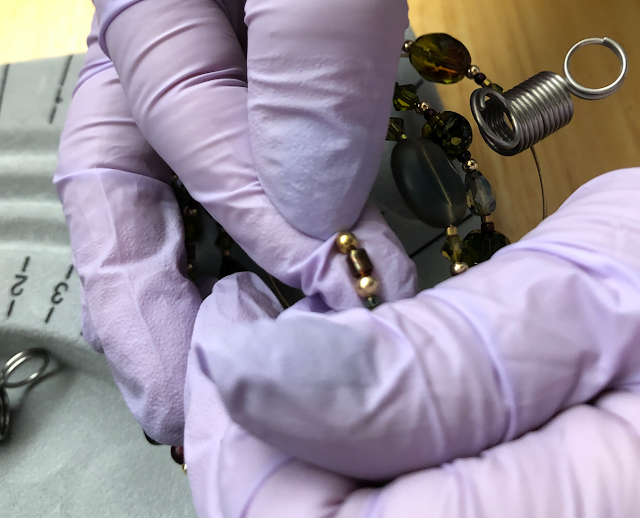
|
| Then, quickly and carefully, push the end cap firmly onto the glued tip of the memory wire. |
Using a fresh piece of cardboard and a fresh toothpick, prepare another small amount of two-part epoxy. Quickly apply a dab to the exposed end of the trimmed wire, align the hole of the memory wire end cap and guide it onto the wire tip. Hold the end cap securely in place for at least 60 seconds, applying pressure from the end with a clean, gloved fingertip. Slowly and carefully remove the pressure, then prop the bracelet with the freshly glued end pointing upward, so that gravity continues to pull it down onto the clipped wire tip.
Allow the epoxy to cure fully, then give the end cap a tug to make sure it is firmly secured to the end of the wire before moving on to Step 8.
Step 8: Trim and Glue the Other End of the Bracelet
Finishing the second end is a bit trickier than the first. Slide the loose beads down the bracelet wire, snugging them firmly against the glued beads at the other end. Use the ultra fine point permanent marker to mark the wire at the last loose bead. Then, carefully slide several beads off that end of the wire and place them in order in a channel of the flocked bead board, making note of which end of the row of beads was at the end of the wire.
Use the memory wire cutters to indent parallel lines into the section of memory wire adjacent to the remaining strung beads, as before. Put on the exam gloves, prepare a small amount of epoxy, re-snug the beads and apply the glue to the section of exposed wire between the end of the strung beads and the mark you made. Quickly slide the beads you removed back onto the wire in the correct order and snug them down onto the glued section. Wipe off any visible epoxy that might have squeezed out onto the adjacent exposed wire. Replace the bead stopper and allow the epoxy to cure fully.
When the glue has cured, carefully remove the bead stopper and tug firmly on the glued beads to ensure that they remain firmly attached to the wire. Examine the adjacent wire carefully, scraping off any tiny areas of cured epoxy residue with a utility blade.
Trim the excess wire, testing the length of the remaining exposed wire at the tip with the memory wire end cap and leaving just slightly more than the depth of the end cap bead hole. If necessary, use the memory wire cutter to impress additional closely-spaced parallel indents into the exposed wire end.
Prepare a small amount of epoxy and glue on the bead cap, applying pressure with a gloved fingertip for at least 60 seconds as before, then prop the bracelet with the freshly glued tip facing up and allow it to cure fully.
Tug on the end cap bead to ensure it is well secured to the end of the wire.
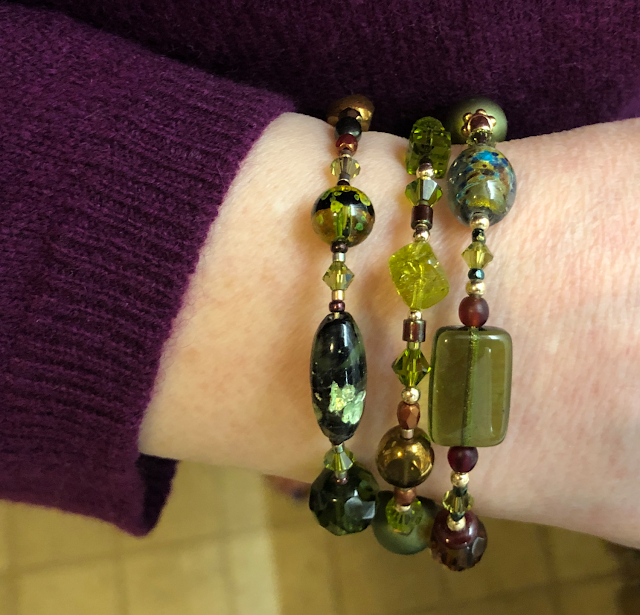
|
| I'm modeling the finished, one-of-a-kind, vintage beaded memory wire wrap bracelet I designed and made as a birthday gift for my dear friend Sally. |
Wear or Give Your Beaded Coil Wrap Bracelet With Pride!
Although I collect rare vintage glass beads and Swarovski crystal beads and love to use them in my jewelry designs, making beautiful beaded memory wire coil wrap bracelets can be as easy or challenging and as inexpensive or costly a project as you decide to make it.
Wouldn't it be fun to get some inexpensive beads from craft stores and find and disassemble beaded jewelry at bargain prices from yard sales and thrift shops, then pick up some memory wire, a heavy duty wire cutter and some epoxy and invite your favorite teens or college students over for a jewelry making "play date?"
I hope you decide to give this beaded coil wrap bracelet project a try. If you do, I would love to see what you make!


